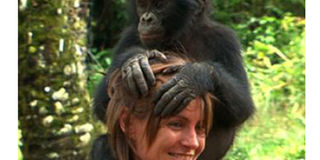Filming chimps

Sabrina Krief shows a side not so often observed about chimpanzees.
What you need to know:
Studying the apes has been shown to provide answers to some of humanity’s most enduring problems, like the discovery of life-saving medicines.
Going by the many different shows on TV today, film, as a tool, can be used to educate more about tourism and science. It is not every day that arts and science come together for a cause. Sabrina Krief takes us through her research on the possibility of human beings using herbal medication for treatment of diseases, like Malaria, among others that affect chimpanzees.
How do chimpanzees, our closest relatives, “get to know” how to avoid poisonous plants and select those that seem to treat them? This is the question that is still tormenting Krief, a veterinarian and lecturer at the National Museum of Natural History. By observing the plants ingested by the chimpanzees in therapy, she hopes to eventually identify active natural substances susceptible to fit in the composition of new drugs for humans.
Perfect partnership
In 2006, Krief partnered with Uganda Wildlife Authority, Makerere University and ICSN-CNRS in France to carry out research on various plant species eaten by chimps. By closely observing their behaviour, Krief made an outstanding discovery. Chimpanzees are able to select plants not only for food but also for medication.
This, according to the researcher, is a form of intelligence that should remind us how close we are to the apes. But we would perhaps never have known much about this research if Mathieu Vidard, presenter of La tête au Carré on French Channel France Inter, hadn’t interested himself in recording what is perhaps Sabrina’s daily life and job into what he called “On a marché sur la terre” (We walked on Earth).
Vidard takes viewers on a worldwide trip visiting the largest open sky laboratories. On April 1, a French TV Channel France 2 broadcast this documentary, which recounts a journey of encountering scientists worldwide.
Recently, a select crowd of guests watched the documentary at the National Museum alongside Krief and Prof. Gilles Boeuf the President of the French Museum of Natural History (MNHN). In “We walked on Earth,” Vidard encounters Krief, a brilliant young primatologist who has for the last 10 years traversed Uganda’s forests to meet the chimpanzees.
Krief’s hope and aspiration are modest. “If we observe the chimpanzees, we may be able to find remedies for common human diseases,” she says in the film. Considering that over four million people watched it in Europe, one wonders how much more this documentary alone would spur in tourist numbers.
Although Sabrina does not see herself going commercial with it, if watched by many other countries, we could perhaps remain perched at the top of tourist destinations for must visits once again. The documentary takes the viewer through the wilderness right into the hearts of forests, home to our distant cousins. Swinging from branch to branch, they fascinate Robert, a pupil in one of the schools near the national parks. “I thought they would be fierce but I see they are peaceful animals,” he tells Vidard.
Used as an ambassador to conserve habitat and preach against trapping gorillas and chimps, Robert and others also present a short skit on awareness and protection of the chimps. Fellow pupils are excited by the skit and seem to have taken in several points, a plus for Krief who sought to sow seeds for future conservationists. “We walked on Earth” basically takes the viewer through Krief’s life as she digs into the life of chimpanzees, how they feed, how they communicate and most importantly how they treat themselves by chewing certain leaves.
“When they shout loudly, they are actually communicating,” Krief explains to Vidard. Although shot in French, English sub titling though with some misspelt words, suffices. The message is not lost. If you have never been to any of Uganda’s tourist destinations, this documentary brings the animals right in your face as you watch what Vidard and group enjoyed during the shoot.
The pictures take you to the parks, you feel like you are actually there and you don’t have to face the challenges like slippery ground taking its toll on Rwenzori Mountain climbers among others shown in the documentary.
Krief and team had to trek to Magherita Peak to let us in on the herbal medicine species available there. According to some clips in the film, we are separated from our chimp ‘cousins’ between eight and 12 million years ago. Although it is still a long way to go, Krief and team would want to finalise with the research.




